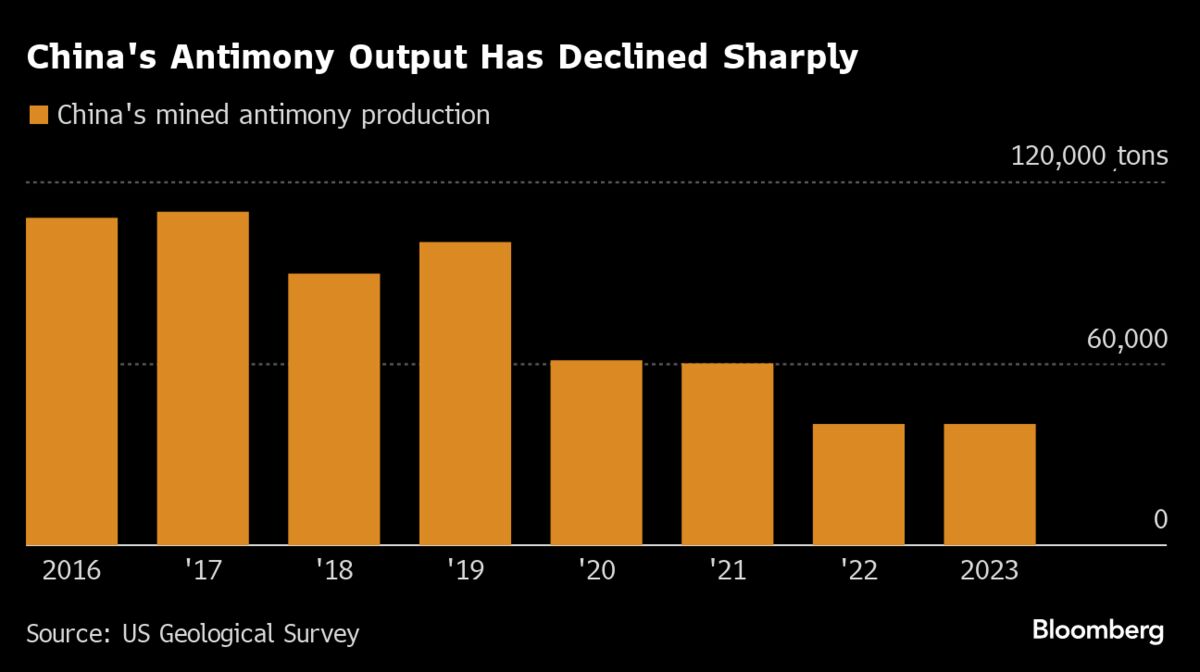Larvotto flies on antimony as China bans yet another critical mineral

Pic: Getty Images
China’s latest geopolitical stab against the West has rounded back to, somewhat expectedly, its monopoly over a range of critical minerals – with now antimony subject to export restrictions by the country.
Previous bans were forewarned, with China releasing plans to restrict exports of germanium and gallium in July last year, which were put into effect 12 days later; and again in October last year with graphite.
The ASX was startled by news on Friday last week that the Middle Kingdom had imposed export restrictions on antimony, as a move seen to purposefully stifle strategic uses of the element.
READ MORE: Shoot across here if you want to know more about China’s bans.
We reap what we sow
Why? Because the rest of the world was more than happy for the nation to be the cheap bread basket using domestic cheap labour and high carbon emission mining, processing and refining methods for a plethora of critical minerals.
Over the decades, the West’s downstream supply chain businesses enjoyed high-profit margins from Chinese exports of commodities such as antimony.
The result? The Middle Kingdom now controls about 80% of production and has consistently flooded the market to lower global prices of the material whenever it suits to stifle the economic viability of developing mines elsewhere.
Flying under the radar though, is a consistent decline in antimony output. According to the US Geological Survey, China produces less than half of what it used to eight years ago.

Umm… what the heck is antimony used for you might ask?
Antimony (Sb) is a semi-metallic chemical element which can exist in two forms: the metallic form is bright, silvery, hard and brittle; the non-metallic form is, well, one of the most explosive materials on the planet.
The Egyptians used it in the form of crushed stibnite as one of their infamous eye makeups, causing all sorts of toxic scarring, sickness and likely deaths.
Nowadays, it’s heavily used in military tech, battery technologies, semiconductors and to strengthen alloys.
Mainland China is the largest producer of antimony on the planet – by quite some margin. It triples Russia’s output and is almost 4X that of Tajikistan. Together, the three BRICS nations control 90% of the world’s output and China controls the supplies of the others.
Resources of the commodity outside this sphere of influence are minute, yet the export bans have called into action dormant projects that can feed into Western supply chains.
In the US, Perpetua Resources has long been intent on restarting the 4.8Moz Stibnite gold mine in Idaho, which can also produce about 18.4Mlb of antimony in the first four years alone.
Yet concerns from environmental and local community groups have stalled the purported US$1.8bn project from getting off the ground. And while that may change with China’s export ban sinking in, production elsewhere across the globe is required to flow into supply chains.
So which ASX juniors are on the (anti)mony?
Certain types of gold deposits actually contain antimony, yet have never been looked at as even a by-product for developing a mining operation because of China’s hegemony over the mineral.
There are, however, a few intrepid ASX gold stocks that actually have some seriously high grades of the stuff – one of them being Larvotto Resources’ (ASX:LRV) Hillgrove gold-antimony project in NSW, which soared 44% on Friday on the back of the news out of China.
LRV’s managing director Ron Heeks, a 35-year veteran of the mining game, says the export restrictions came as bit of a surprise.
“We’d been hearing it was all but in place anyway, but for them [Chinese government] to come out so strongly it’s had a significant effect on those of us with large amounts of antimony credits at our projects.”
Heeks’ perspective is about taking the positives out of the scenario. “It’s highlighted the shortage of antimony and the fact we have a world-class resource of the commodity.”
While the US government seems to want to splash billions into Perpetua, Heeks highlights the fact that LRV’s own antimony credits are far bigger than its Stibnite resource.
“We’ve got 90,000 tonnes of the stuff and we’re moving into our definitive feasibility stage and we believe we can move very quickly,” Heeks says.
“It was run as an antimony mine up until 2005 so it’s on the record of having done that, and it was only put on pause because the antimony price went down to $1500/t.”
Over the course of its recent lifetime, Hillgrove has received more than $180m worth of investment (since 2004), through previous owners Straits Resources and later Bracken, which paid $33.2m for it in 2013 and ended up putting it on care and maintenance once again until Red River Resources (ASX:RVR) swooped in and bought it for $4m, spending $20m on exploration itself.
Late last year, LRV purchased Hillgrove for a knockdown price of $8m, and it looks like the timing of the acquisition has boded well in terms of the prices of both gold and antimony rising.
At a conservative US$15,000/t for its 90kt-worth of Sb and its gold endowment, the project has a development capex of $72m and an NPV8 of $157m, yet at spot prices of both Au and Sb, the NPV8 sits at a jaw-dropping $383m and an IRR of 114%.
Larvotto was up a further 25% this morning as investors absorbed the news.
Other ASX juniors in the antimony biz include earlier-stage Southern Cross Gold (ASX:SXG) near Australia’s only producing antimony mine, Costerfield, and Nagambie Resources’ (ASX:NAG) nearby 17,800t Sb resource, both of which also rose in share price on the restriction news.
SXG was rising almost 10% today after also releasing new exploration results from its Sunday Creek project in Victoria, while NAG was up ~8% in morning trade and TSX-listed Mandalay, which owns Costerfield, is up almost 10% in the past week in Toronto.
This article does not constitute financial product advice. You should consider obtaining independent advice before making any financial decisions.
Related Topics
UNLOCK INSIGHTS
Discover the untold stories of emerging ASX stocks.
Daily news and expert analysis, it's free to subscribe.
By proceeding, you confirm you understand that we handle personal information in accordance with our Privacy Policy.








